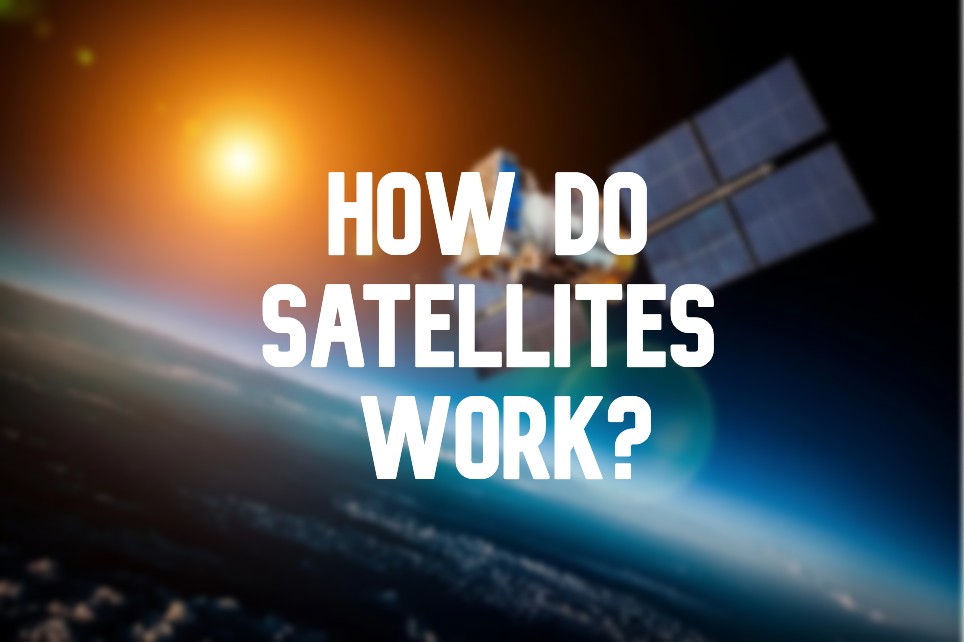Technology in Space: How Do Satellites work
19th Sep 2022
Socrates said: “Man must rise above the earth — to the top of the atmosphere and beyond — for only thus will he fully understand the world in which he lives.” Already in the 5th century BC, the Greek philosopher understood how valuable a view of the Earth from space could be, although he had no notion of how this could be achieved in practice.
We had to wait for over two thousand years until, in 1729, Isaac Newton published his famous cannonball thought experiment, which actually describes how Earth satellites work. The experiment visualises a cannon, which is located on a very high mountain and fires a cannonball at an angle of 90 degrees to the Earth. If the cannonball moves too slowly, it will eventually fall down to Earth. If it moves very quickly, it could break free from Earth’s gravity and head into space. If it reaches the average speed, it will move in the orbit of the Earth.
In 1957, the USSR practically confirmed Newton’s guess by launching the first artificial satellite into orbit. Since then, the number of various satellites in space has exceeded several thousand, and their service to the benefit of humanity cannot be overestimated. So, let’s find out how a satellite works and what tasks it performs.
What is a satellite?
Before determining how satellites work, let’s consider the definition. A satellite is any object that orbits another larger object and is held there by the larger object’s gravity. A satellite can be of natural origins, such as the Moon to the Earth, or it can be artificially made. The latter type includes all artificial earth satellites, spacecraft, and even the International Space Station.
Artificial satellites are not created for their beauty (that would be too expensive) but to perform special tasks. It can be navigation, communications, photo and video imaging of the Earth, various kinds of research, defence, or intelligence. Simply put, the extraction and transmission of information using a satellite is the main reason why we need them. Depending on their purpose, satellites can come in different sizes and carry different equipment.
What is a satellite made of?
A satellite is a complex high-tech semi-autonomous system that includes two equipment types:
- The payload, including equipment, various scientific tools, and antennas, is all designed to solve the target tasks of the satellite.
- Platforms that ensure normal satellites work in orbit:
- a power supply system consisting of an energy source (usually solar and chemical batteries);
- onboard control complex that provides management of service systems and payload, as well as monitoring their technical condition;
- system of orientation, stabilisation and motion control to ensure the orientation of the satellite in space (solar sensors, sensors of the Earth’s infrared radiation, gyroscopes, flywheels, electromagnetic devices, etc.);
- a thermal control system that ensures the thermal regime of the onboard equipment (thermal control coatings, heat pipes, liquid subsystems, etc.);
- propulsion systems for correcting the height of the satellite’s orbit and its orientation;
- a body or a bus that provides accommodation for all equipment.
And now let’s find out how do different types of satellites work in space depending on their intended purpose.
How do communication satellites work
More than half of 5,000+ satellites in orbit are communications satellites. This is not surprising. It is unlikely that you know anyone on Earth who would not use TV, the Internet, or a mobile phone. And their work is ensured by communication satellites.
The onboard radio equipment of such satellites receives signals from ground radio stations, which can be located at a distance of up to 15 thousand km from each other, amplifies them and retransmits them to other ground radio stations. The area in which a satellite signal can be received from a given satellite is called the coverage area. The most common example of how communication satellites are used in everyday life is satellite TV.
How do TV satellites work
A satellite transmits the signal to the satellite television service, which relays it to the consumer’s outdoor parabolic antenna (satellite dish) and downconverter unit. The satellite receiver then decodes the desired program for viewing on the TV. Receivers can be either external set-top boxes or a built-in TV tuner. Satellite signals are transmitted in the X band (8-12 GHz) or Ku band (12-18 GHz), for which a dish less than a meter in diameter is sufficient.
TV satellites are usually placed on a GSO 23,000 miles above the Earth’s equator. There, the orbital rotation speed of the satellite is equal to the speed of the Earth’s rotation, so the spacecraft occupies a fixed position in the sky, and the satellite dish does not need to track it every time.
How do Internet satellites work
We will answer this question using the example of the world’s largest satellite Internet provider, Starlink. The next Elon Musk project is designed to provide high-speed Internet access to remote areas of the Earth where the coverage is either poor, non-existent, or has a low speed. For this, over 12,000 satellites will be placed in low orbit, which should ultimately ensure speeds of up to 1 Gb per second without any restrictions. This is more than enough even for large households in need of high-speed Internet.
How do Starlink satellites work
The Starlink service relies on a system of ground stations called gateways. These stations are located all over the world and exchange signals with Starlink satellites, connecting them to the existing fibre optic infrastructure. Thus, the user’s home antenna connects to the Starlink satellite when they are in range, which in turn links them to the nearest gateway. So, in addition to their own antenna, users must be within 500 miles of the ground station to receive service.
However, things could change soon. Starlink engineers have already experimented with a batch of test satellites that use lasers for communication. Instead of connecting users’ antennas to the nearest ground station, lasers would allow satellites to communicate directly with each other at the speed of light.
How do cell phones work with satellites
Since a cell phone is also a means of communication, many mistakenly believe that it must work with a satellite. This opinion arises from confusing cell and mobile phones. A mobile phone can be any wireless phone, including cellular and satellite phones. The difference between them is how the signal is transmitted.
Communication to cell phones is provided by Earth-based ground stations of cellular operators. How do satellite phones work? A satellite phone, as the name implies, transmits radio waves via a satellite. The farther they are from the Earth, the greater the signal delay; this also means that the phone needs a longer antenna. However, the advantage of satellite phones is that they have wider coverage.
So, how do cell phones work with satellites? Through navigation alone. And this leads us to another question.
How do navigation satellites work
Navigation satellites are used to determine the location coordinates of objects on Earth. These can be both ordinary people using, for example, the Google Maps application on a smartphone, and aircraft, ships, cars, in other words, any stationary or mobile object. Satnav consists of three segments: space (satellite), control (terrestrial antenna network), and user (your portable receiver). Several satellites transmit radio signals to the receiver so you can determine your location, speed and local time with high accuracy. Location is determined by triangulation (by three signals) or trilateration (by 4 signals). That is the way GPS satellites work. And so far, other systems such as the European Galileo, the Russian Glonass and the Chinese Beidou cannot match it in terms of accuracy.
How do weather satellites work
Thanks to these satellites, we can predict the weather. Of course, the forecast is not always accurate. How does it work? Sensors on weather satellites scan the Earth, making measurements of reflected light and infrared temperature. These measurements are then digitised and sent back to Earth, where they can be converted into images.
Due to the sophisticated measuring equipment, the mass of such satellites can reach several tons, and so that they can cover the largest possible area for monitoring and to obtain as much accurate data as possible, they are placed in geostationary or polar orbits.
Conclusion
It is obvious that satellites are firmly integrated into our everyday life, and without them, many daily operations are already unthinkable. Satellites help us not only to ensure safety and comfort on Earth but also act as one of the technological progress driving forces. Humanity is rapidly developing and improving satellite technology. And it is possible that soon, the question of how satellites work will have a completely different answer.






Thank you for your comment! It will be visible on the site after moderation.